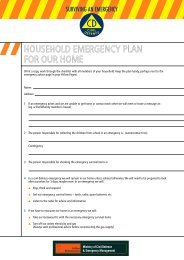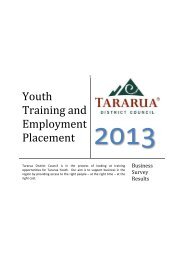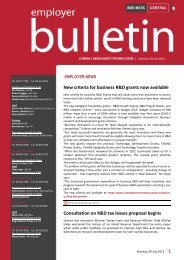Food Control Plan Checklist - Tararua District Council
Food Control Plan Checklist - Tararua District Council
Food Control Plan Checklist - Tararua District Council
- No tags were found...
Create successful ePaper yourself
Turn your PDF publications into a flip-book with our unique Google optimized e-Paper software.
Serve SafePreparation1 Goal 2 Why?To prevent food from contamination during preparation from:• microbes eg, bacteria and viruses• physical eg, hair, packaging• chemicals eg, cleaning chemicals, pesticides.To prevent the growth of harmful microbes that may bepresent in food from multiplying to harmful numbers.• Harmful microbes will grow rapidly at temperaturesbetween 4ºC to 60ºC (the temperature danger zone).• Harmful microbes can contaminate food through uncleanpeople, equipment and utensils.• <strong>Food</strong> contaminated by chemicals can cause illness.• Objects can fall into uncovered food affecting its suitabilityand/or safety.3 How this is done• <strong>Food</strong> preparation surfaces are clean andsanitised before use (see Cleaning andsanitising).• Good personal hygiene practices are followed(see Hand hygiene and Personal hygiene).Fruit and vegetablesThe outer surfaces of fruit and vegetables are washedbefore cutting or serving to reduce any chemicals or harmfulmicrobes present.EggsWhole eggs are free from cracks and are clean.Break eggs into a clean container before adding toother ingredients. This will prevent the possibility ofthe ingredients becoming contaminated by piecesof broken egg shell.Piping bags[tick as appropriate]Disposable single-use piping bags are used.Re-usable piping bags are used, and:they are cleaned and sanitised between tasksseparate piping bags are used for different purposespiping bags are replaced as appropriateDehydrated productsOnce milk or water is added to products such aspotato flakes/granules, custard powder etc theyshould be used immediately, or either kept chilled(at or below 4ºC) or hot (at or above 60ºC).Time, temperature and food safetyThe time readily perishable food is left at room temperature(the temperature danger zone) during preparation is kept to aminimum (this also includes batter mixes etc).When not in use, readily perishable food/ingredients are keptat or below 4ºC.When using egg pulp, pasteurised egg pulp is used foruncooked or lightly cooked foods.Avoid cross-contaminationNever use the same equipment or utensils (eg,knives, plates, containers etc) for raw and readyto-eatfood – unless they have been thoroughlycleaned, sanitised and dried between tasks.Ready-to-eat food is protected from contamination fromsurfaces (including equipment and utensils) that have comeinto contact with raw or uncooked food by:using a defined area in the kitchen to prepare raw foodthat is separate from cooked or ready-to-eat food, orpreparing raw and ready-to-eat food at different timeswith thorough cleaning and sanitising in between.The following chopping boards are used for each of these foods:• *raw meat• *raw poultry• *raw fish• *fruit and vegetables• *cooked meat and poultry4 What if there is a problem?Throw away any ready-to-eat food that has becomecontaminated.Change practices and/or retrain staff where necessary.Glass breakageIf a glass object or window breaks in the kitchen:• clean up the broken glass immediately• throw out any uncovered food in the surrounding area• check the area carefully for glass• dispose of glass fragments in an outside rubbish bin(not the kitchen).5Write it downWrite down in the Diary what action youtook if food has not been prepared correctly.* Write down which chopping board is used (eg, red for raw meat)<strong>Food</strong> <strong>Control</strong> <strong>Plan</strong> Version 3.0 2011S6







